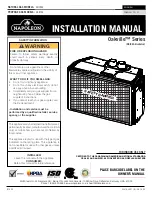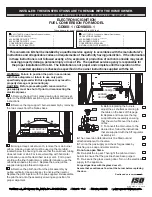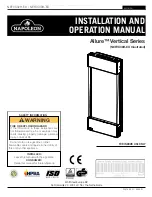
Quadra-Fire • QFP38 Series • 4061-300 Rev i • 9/09
64
16
16
Troubleshooting
With proper installation, operation, and maintenance your gas appliance will provide years of trouble-free service. If you
do experience a problem, this troubleshooting guide will assist a qualifi ed service technician in the diagnosis of a problem
and the corrective action to be taken. This troubleshooting guide can only be used by a qualifi ed service technician. Con-
tact your dealer to arrange a service call by a qualifi ed service technician.
The normal behaviors of the board could be inhibited by
the anomalies described in the following tables.
Note on the automatic ignition sequence:
• The supervised pilot fl ame detection is activated only
after a command is correctly received.
•
The sparking means are activated only after no parasitic
fl ame is detected, before the ignition.
• The pilot gas valve is energized, and the gas will fl ow,
only after the sparking means are activated.
Note:
To reset the ignition module lockout - turn the unit off for fi ve seconds, then back on.
Symptom
Possible Cause
Corrective Action
1.
The ignitor/
module makes
noise, but no
spark.
a.
Incorrect wiring.
Verify “S” wire (white) for sensor and “I” wire (orange) for ignitor are connected to the
correct terminals on the module and the pilot assembly. Reversed wires at the module
may cause the system to make a sparking noise, but the spark may not be present at
pilot hood.
b.
Loose connections or
electrical shorts in the wiring.
Verify there are no loose connections or electrical shorts in wiring from module to
pilot assembly. The rod closest to the pilot hood should be ignitor. Verify connections
underneath pilot assembly are tight; also verify the connections are not grounding out
to the metal chassis, pilot burner, pilot enclosure, mesh screen if present, or any other
metal object.
c.
Ignitor gap is too large.
Verify gap of ignitor to pilot hood. The gap should be approximately .17 in. or 1/8 in.
d.
Faulty module.
Turn ON/OFF rocker switch or wall switch to OFF position. Remove ignitor wire “I”
from module. Place ON/OFF rocker switch or wall switch in ON position. Hold ground
wire about 3/16 in. away from “I” terminal on module. If there is no spark at “I” terminal,
module must be replaced. If there is a spark at “I” terminal, module is fi ne. Inspect pilot
assembly for shorted sparker wire or cracked insulator around electrode.
2.
Pilots won’t light,
there is no noise
or spark.
a.
Fireplace burner control
installed incorrectly.
Verify that fi replace burner control is installed and plugged into module. Check voltage
of transformer under load at space connection on module with ON/OFF switch in ON
position. Acceptable readings of a good transformer are between 3.2 and 2.8 volts AC.
b.
A shorted or loose
connection in wiring
confi guration or wiring
harness.
Remove and install the wiring harness that plugs into module. Verify there is a tight fi t.
Verify pilot assembly wiring to module. Remove and verify continuity of each wire in
wiring harness.
c.
Module not grounded.
Verify green ground wire from module wire harness is grounded to metal chassis of
appliance.
d.
No gas fl ow out of pilot
burner.
Check gas mains supply and pressure. Check gas valve wirings and connections to the
board. Check for pilot burner obstruction.
e.
No ionization current
established through fl ame
within ignition time.
Remove/clean eventual bridging carbon deposits betweeh the pilot burner and the
ionization rod.
f.
No gas fl ow out of pilot
burner or pilot gas presure
dropout upon main burner
gas valve opening.
Check gas mains supply and pressure. Check the correct gas type setting on the valve
and pilot burner assembly orifi ce.
g.
No spark generation.
Check parasitic pilot fl ame existence.
h.
No spark voltage reaches
the spark rod, or spark
developes near pilot
assembly.
Check for cracks in the rod ceramic insulator, replace as necessary. Check pilot
assembly wirings and spark return connections to the board.
• The main burner gas valve is energized, and gas will
fl ow, only if commanded and after the supervised pilot
fl ame is detected to be continuously lit.
• The system will try two times for ignition.
• Each try for ignition will last approximately 60
seconds.
• The wait time between the two tries is approximately 35
seconds.
• If there is no positive ignition, after two tries, the ignition
module will go into lockout.
A. Troubleshooting













































